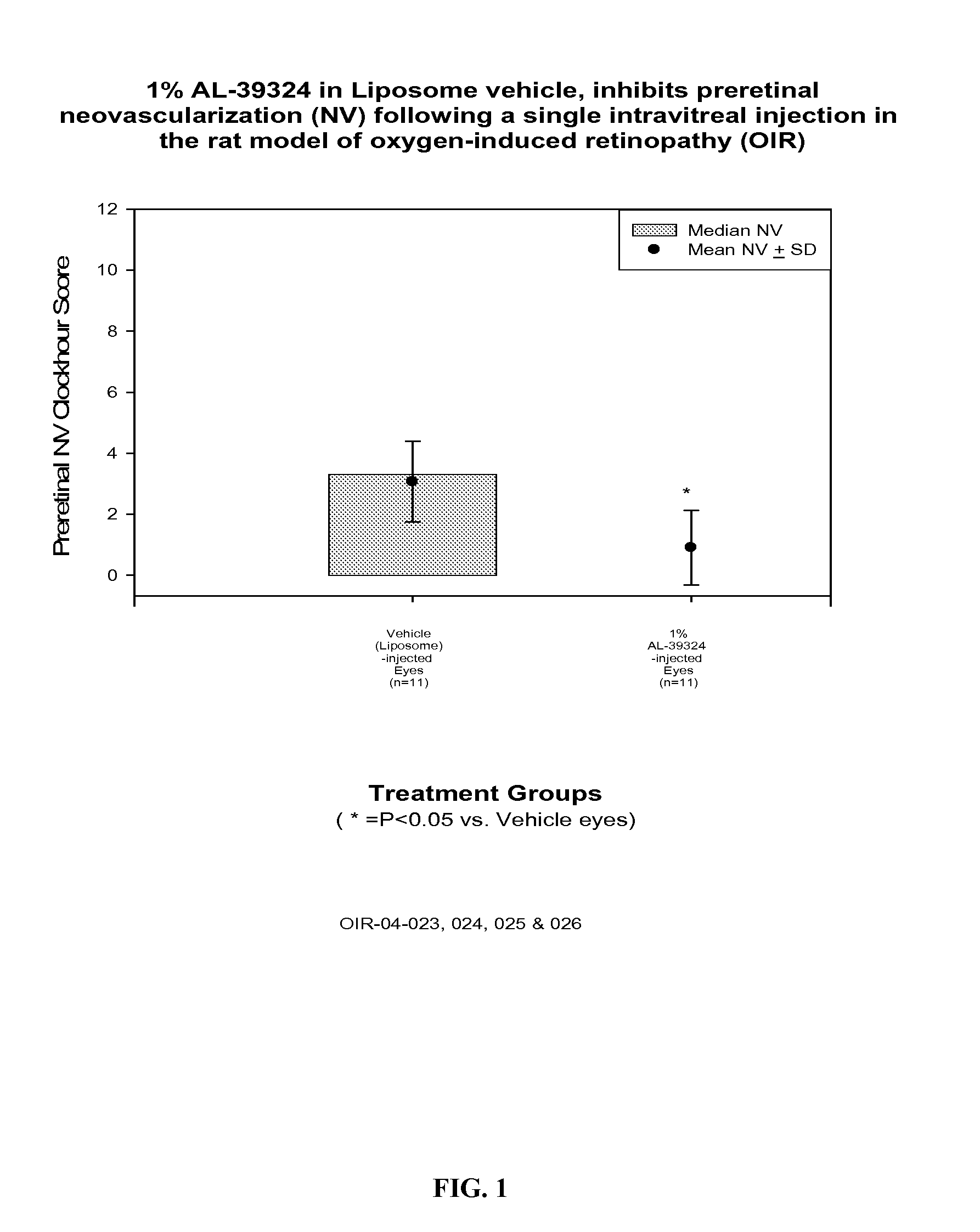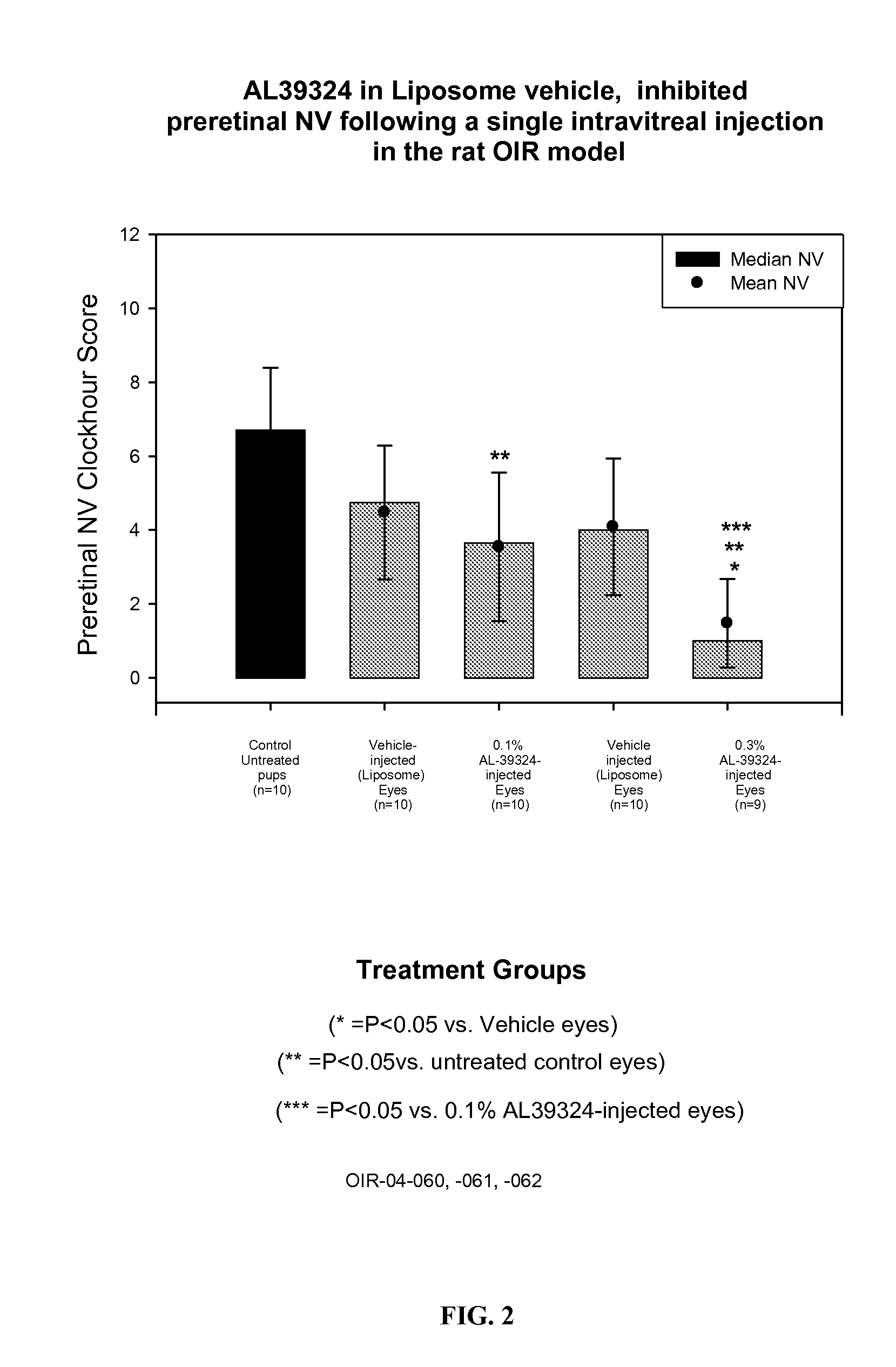PHARMACEUTICAL FORMULATION FOR DELIVERY OF RECEPTOR TYROSINE KINASE INHIBITING (RTKi) COMPOUNDS TO THE EYE
a technology of receptor tyrosine kinase and drug delivery, which is applied in the direction of biocide, cardiovascular disorder, drug composition, etc., can solve the problems of affecting the vesicle structure and solubility ability of the micelles, and affecting the drug release rate. , to achieve the effect of reducing the vesicle structure and solubility of the micelles, reducing the vesicle structure and reducing the vesicle pore ratio
- Summary
- Abstract
- Description
- Claims
- Application Information
AI Technical Summary
Benefits of technology
Problems solved by technology
Method used
Image
Examples
example 1
[0039] This example illustrates the preparation of a DMPC based liposome vehicle for intravitreal application.
IngredientsAmount (w / v, %)Phospholipid (1,2-Dimyristoyl-sn-9phosphatidylcholine, DMPC)Dibasic sodium phosphate, dodecahydrate0.36Sodium chloride0.8Sodium hydroxideq.s. to pHHydrochloric acidq.s. to pHWater for Injectionsq.s. to 100
[0040] 9 g DMPC was dissolved in about 20 mL ethanol. To it was added about 1 g of 0.36% dibasic sodium phosphate solution. Swirl well to make a homogeneous solution. The liquid was removed to a dry thin film by using a rotatory evaporator at 40° C. It was left at vacuum for 4 h. The film was hydrated by addition 80 g of a sterile buffer solution containing 0.36% dibasic sodium phosphate and 0.8% sodium chloride (pH 7.2). Finally q.s to 100 g with the same buffer solution. The solution was stirred at RT for 2 h. This vehicle was injected in rat OIR model and the results are shown in FIG. 1.
example 2
[0041] This example illustrates the preparation of a representative pharmaceutical liposome formulation for intravitreal and topical administration containing a RTKi (N-[4-(3-amino-1H-indazol-4-yl) phenyl]-N′-(2-fluoro-5-methylphenyl) urea).
IngredientsAmount (w / v, %)RTKi1Phospholipid (1,2-Dimyristoyl-sn-9phosphatidylcholine, DMPC)Dibasic sodium phosphate, dodecahydrate0.36Sodium chloride0.8Sodium hydroxideq.s. to pHHydrochloric acidq.s. to pHWater for Injectionsq.s. to 100
[0042] In a 250 mL round bottom flask 1 g sterile RTKi raw material was taken. The compound was dissolved in 20 mL tetrahydrofuran / ethanol (1 / 5) solvent system. To it was added 9 g DMPC and added another 5 mL ethanol. To the above solution was added 1.5 mL of sterile 0.36% dibasic sodium phosphate, dodecahydrate solution. Swirl well to get a clear colorless solution. The liquid was removed using a rotatory evaporator at 40° C. and left at vacuum for 4 h. Q. s. to 100 g by addition of a buffer solution containing ...
example 3
[0043] This example illustrates the preparation of a representative pharmaceutical liposome formulation for PJ and periocular administration containing a RTKi (N-[4-(3-amino-1H-indazol-4-yl) phenyl]-N′-(2-fluoro-5-methylphenyl) urea).
IngredientsAmount (w / v, %)RTKi3Phospholipid (1,2-Dimyristoyl-sn-27phosphatidylcholine, DMPC)Dibasic sodium phosphate, dodecahydrate0.36Sodium chloride0.7Sodium hydroxideq.s. to pHHydrochloric acidq.s. to pHWater for Injectionsq.s. to 100
[0044] In a 250 mL round bottom flask 3 g sterile RTKi raw material was taken. The compound was dissolved in 60 mL tetrahydrofuran / ethanol (1 / 5) solvent system. To it was added 27 g DMPC and added another 5 mL ethanol. To the above solution was added 3.0 mL of sterile 0.36% dibasic sodium phosphate, dodecahydrate solution. Swirl well to get a clear colorless solution. The liquid was then removed at 40° C. using a rotatory evaporator and left at vacuum for 4 h. Q. s. to 100 g by addition of a sterile buffer solution con...
PUM
| Property | Measurement | Unit |
|---|---|---|
| Fraction | aaaaa | aaaaa |
| Fraction | aaaaa | aaaaa |
| Fraction | aaaaa | aaaaa |
Abstract
Description
Claims
Application Information
 Login to View More
Login to View More - R&D
- Intellectual Property
- Life Sciences
- Materials
- Tech Scout
- Unparalleled Data Quality
- Higher Quality Content
- 60% Fewer Hallucinations
Browse by: Latest US Patents, China's latest patents, Technical Efficacy Thesaurus, Application Domain, Technology Topic, Popular Technical Reports.
© 2025 PatSnap. All rights reserved.Legal|Privacy policy|Modern Slavery Act Transparency Statement|Sitemap|About US| Contact US: help@patsnap.com



